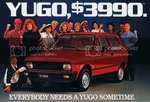four-walling
Kerry, San Diego

http://www.bbc.com/autos/story/20151126-in-praise-yes-praise-of-the-yugo
The world's last truly awful car?
Thirty years ago, the $3,990 Yugo GV landed on the shores of the United States of America. The GV stood for “Good Value,” a marketing sentiment so nakedly brazen, so rich in the damnation of faint praise, that the car could not help but fail to clear even that low hurdle.
We’d had the Nova, the Pinto, and the Vega before — truly awful cars that had aspired to roadworthiness — but the idea of building a car on a chassis made of value proposition was a new and compelling one. Everyone should to have an inexpensive and economical means of personal transportation, said the optimistic-’80s zeitgeist, and entrepreneur Malcolm Bricklin set about to give Americans their due.
He was the perfect man to do it. Bricklin had brought the then-obscure Subaru brand to the US in 1968, and made a killing. After a failed try at a from-scratch sports car called (humbly) the Bricklin SV-1, he began importing Fiat roadsters, rechristening them as the Pininfarina and Bertone X1/9. When the ’80s rolled around with unstable gas prices, Lee Iacocca hawking Chrysler K-cars, and second-tier Asian imports flooding the market (the $4,995 Hyundai Excel was destined for dealers by 1985), Bricklin went knocking in the Soviet Bloc.
Yugoslav manufacturer Zastava Koral had been building variants of the Fiat 127 under license, and the design — sporty in a Volkswagen Rabbit sort of way — seemed perfect for America. Bricklin, with help from Henry Kissinger and Lawrence Eaglebuger (yes, this is a Totally 80s flashback), negotiated a deal. He showed off the car at the LA Auto Show in 1984, and made his own show of the 500 improvements that were to be implemented for American drivers and the team of British quality experts he had on the ground in Kragujevac.
Though its top speed was just 86mph (the slowest of any US-market car), it sold briskly, breaking records for European imports at 163,000 over three years. Bricklin sold out in 1988, and by 1992, the worsening political climate in the Balkans put a stop to exports. In 1999, NATO bombed the production factory, mistaking it for the company’s munitions plant.
But the bomb had gone off years before. Americans were trained to distrust anything with a whiff of communism about it, and the Yugo was instantly the butt of jokes (in our memory, they were all made by Jay Leno). They were the tasteless vehicle behind the tasteless Bette Midler vehicle Drowning Mona, a movie that still played the Yugo for laughs in 2000 (and probably still keeps Jamie Lee Curtis up at night).

That Yugos were so cheap might very well have been their undoing. Mechanics (at lawn mower repair shops, we assume) reported that customers tended to treat their Yugos as disposable cars, because when you’ve paid less than $4,000, little things like tires and oil changes start to seem like throwing good money after bad. You could double a Yugo’s value by just filling the tank, said someone who wasn’t Leno, probably. In 1986, Saturday Night Live did the Yugo one better with an ad for the imaginary Adobe, a Mexican-made, $179 car fashioned entirely of clay. "You could buy a cheaper car," said pitchman Phil Hartman, "but I wouldn't recommend it."
How bad was the Yugo, really? In 1987, Popular Mechanics magazine released a survey of Yugo owners, in which 78% percent rated the quality of their cars at good to excellent, and 25% excellent, and 42% said they’d buy one again. (This article is either a stern refutation of conventional wisdom, or the first large-scale study of Stockholm Syndrome conducted by a major magazine.) But critics everywhere panned the car as underpowered and undependable. Safety and pollution were becoming major concerns, leading to regulatory hurdles that the Yugo would never be able to pass.
Just three years into the experiment, Yugo sales had peaked, though they continued to sell in dwindling numbers until that 1992 embargo (and to be produced in Serbia until 2008). Consumerist, Day-Glo, Reaganite America could no longer afford to look cheap, especially as Japan invaded from the Pacific with cars — an army of Corollas and Civics and Sentras — that cut no corners on safety, reliability or build quality. This new computerised manufacturing environment closed the market to cars made of spot-welded compromise. The Yugo would be the world’s last truly execrable car, left by the side of the road after its glorious, steaming moment in the sun.















